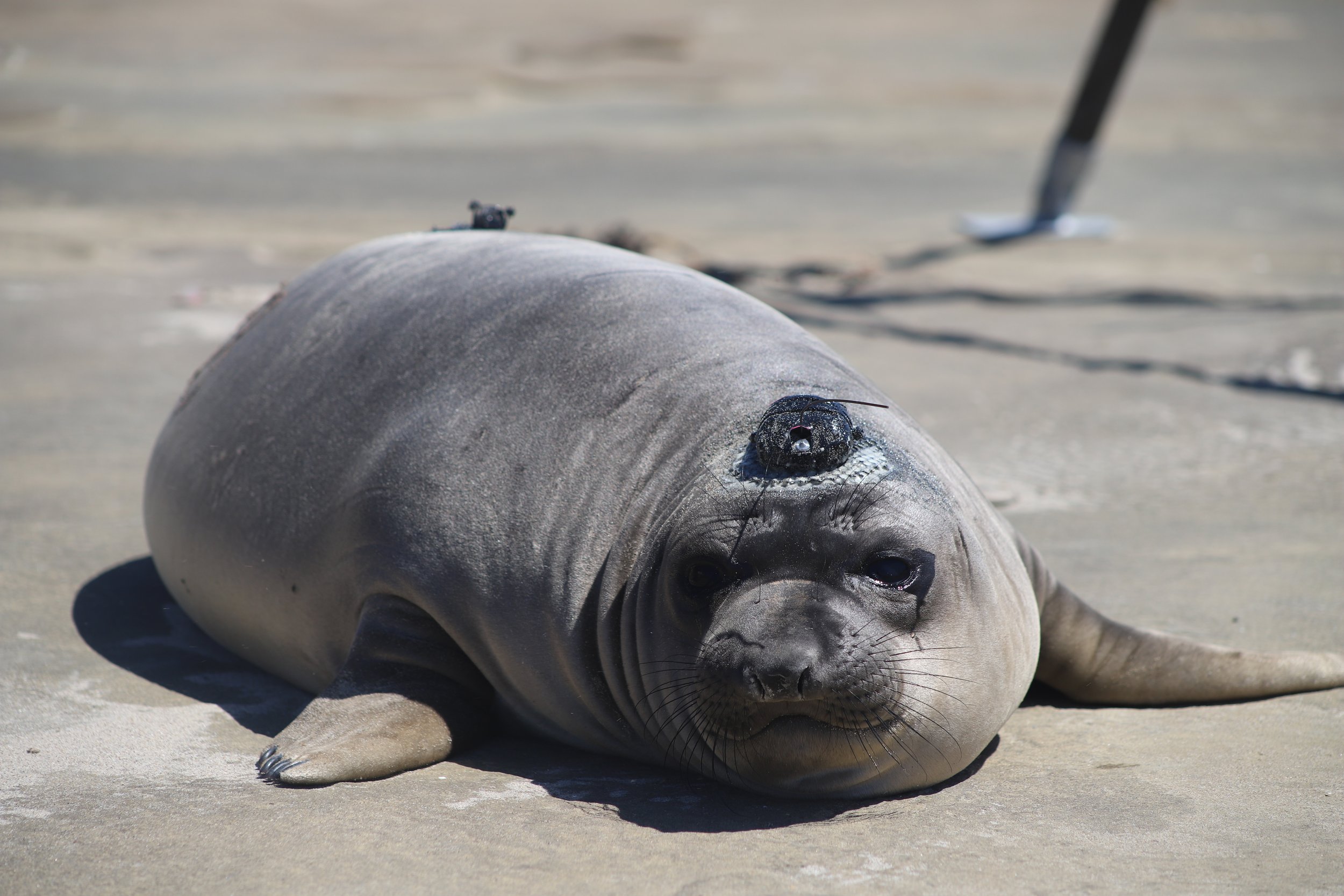Movement of weaned northern elephant seal pups
during their first at-sea foraging migration
Weaned elephant seal pup “Eclipse” with a satellite tag on his head. Activities performed and image taken under NMFS permit 27514.
The northern elephant seal is an amazing marine mammal that embarks on huge foraging migrations each year. Adult males venture all the way up the coast to Alaska, and adult females go hundreds of mile out into open ocean. Despite the extensive knowledge the scientific community has on adult migrations in this species, very little is known about where the pups go when they first leave the beach.
Northern elephant seal pups are typically born in December and January, and they nurse for 4 weeks before they are weaned. After weaning, they remain on the beach for 6-8 weeks, completing their development and occasionally swimming nearshore, or in coastal ponds and rivers. Once they get hungry enough, they leave the beach and venture into the ocean to find food. Our project aims to determine the migration pathways of weaned northern elephant seal pups during their very first foraging migration.
This year, we tagged weaned pups at Vandenberg Space Force Base (Lompoc, CA) and on San Nicolas Island, CA, to compare the migration patterns of pups born at a newly established breeding site (Vandenberg) and a long-established site (San Nicolas).
Meet our seals!
Eclipse
Date tagged: 04/08/2024
Sex: Male
Mass: 113.8 kg (250.8 lb)
Dye mark: R88
Eclipse was our first seal tagged at San Nicolas Island. He was tagged during the solar eclipse, which is how he got his name.
Comet
Date tagged: 04/08/2024
Sex: Male
Mass: 105 kg (231.5 lb)
Dye mark: R89
Comet was named after the cosmic snowballs that orbit the sun, leftover from the formation of the solar system.
Cassiopeia
Date tagged: 04/09/2024
Sex: Female
Mass: 75.2 kg (165.8 lb)
Dye mark: R92
Cassiopeia was named for the constellation, which bears the name of a queen in Greek mythology; she was said to be the mother of Andromeda and someone who boasted of her beauty.
Pegasus
Date tagged: 04/09/2024
Sex: Female
Mass: 94 kg (207.2 lb)
Dye mark: R94
Pegasus was named for the constellation, which is prominent in the northern sky and is named from the winged horse in Greek mythology.
Andromeda
Date tagged: 04/09/2024
Sex: Female
Mass: 100.4 kg (221.3 lb)
Dye mark: R96
Andromeda was named for the closest major galaxy to the Milky Way. In Greek mythology, Andromeda was the daughter of queen Cassiopeia and king Cepheus.
Aurora
Date tagged: 04/11/2024
Sex: Female
Mass: 85.2 kg (187.8 lb)
Dye mark: A369
Aurora was our first seal tagged at Vandenberg this year. She was named for the beautiful light displays visible at high latitudes (aurora borealis in the north, aurora australis in the south). The auroras are caused by magnetic disturbances due to solar wind.
Oberon
Date tagged: 04/11/2024
Sex: Male
Mass: 82.8 kg (182.5 lb)
Dye mark: A358
Oberon was named after the outermost moon of the planet Uranus. In medieval and Renaissance literature, and in Shakespeare’s A Midsummer Night’s Dream, Oberon was the king of the fairies.
Seal degrasse tyson
Date tagged: 04/11/2024
Sex: Male
Mass: 85.2 kg (187.8 lb)
Dye mark: A370
This seal was named after Neil deGrasse Tyson, an American astrophysicist and well-known science communicator. Dr. Tyson has made astrophysics more accessible to the general public, and we wanted to honor his efforts.
Dipper
Date tagged: 04/12/2024
Sex: Female
Mass: 98.4 kg (216.9 lb)
Dye mark: A332
Dipper was named for the constellations Ursa Major (the Big Dipper) and Ursa Minor (the Little Dipper), both of which are usually visible in the northern sky in the spring.
Pluto
Date tagged: 04/12/2024
Sex: Female
Mass: 94.4 kg (208.1 lb)
Dye mark: A366
This seal was named in honor of Pluto, which was once considered the 9th planet of our solar system but has since been reclassified as a dwarf planet.
Curious about last year’s satellite tagged seals? Click here to see their tracks and profiles!











